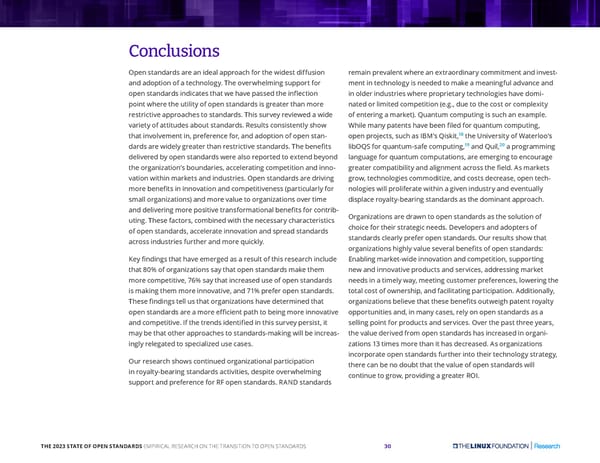Conclusions Open standards are an ideal approach for the widest diffusion remain prevalent where an extraordinary commitment and invest- and adoption of a technology. The overwhelming support for ment in technology is needed to make a meaningful advance and open standards indicates that we have passed the inflection in older industries where proprietary technologies have domi- point where the utility of open standards is greater than more nated or limited competition (e.g., due to the cost or complexity restrictive approaches to standards. This survey reviewed a wide of entering a market). Quantum computing is such an example. variety of attitudes about standards. Results consistently show While many patents have been filed for quantum computing, that involvement in, preference for, and adoption of open stan- 18 the University of Waterloo’s open projects, such as IBM’s Qiskit, 19 20 dards are widely greater than restrictive standards. The benefits libOQS for quantum-safe computing, and Quil, a programming delivered by open standards were also reported to extend beyond language for quantum computations, are emerging to encourage the organization’s boundaries, accelerating competition and inno- greater compatibility and alignment across the field. As markets vation within markets and industries. Open standards are driving grow, technologies commoditize, and costs decrease, open tech- more benefits in innovation and competitiveness (particularly for nologies will proliferate within a given industry and eventually small organizations) and more value to organizations over time displace royalty-bearing standards as the dominant approach. and delivering more positive transformational benefits for contrib- uting. These factors, combined with the necessary characteristics Organizations are drawn to open standards as the solution of of open standards, accelerate innovation and spread standards choice for their strategic needs. Developers and adopters of across industries further and more quickly. standards clearly prefer open standards. Our results show that organizations highly value several benefits of open standards: Key findings that have emerged as a result of this research include Enabling market-wide innovation and competition, supporting that 80% of organizations say that open standards make them new and innovative products and services, addressing market more competitive, 76% say that increased use of open standards needs in a timely way, meeting customer preferences, lowering the is making them more innovative, and 71% prefer open standards. total cost of ownership, and facilitating participation. Additionally, These findings tell us that organizations have determined that organizations believe that these benefits outweigh patent royalty open standards are a more efficient path to being more innovative opportunities and, in many cases, rely on open standards as a and competitive. If the trends identified in this survey persist, it selling point for products and services. Over the past three years, may be that other approaches to standards-making will be increas- the value derived from open standards has increased in organi- ingly relegated to specialized use cases. zations 13 times more than it has decreased. As organizations incorporate open standards further into their technology strategy, Our research shows continued organizational participation there can be no doubt that the value of open standards will in royalty-bearing standards activities, despite overwhelming continue to grow, providing a greater ROI. support and preference for RF open standards. RAND standards THE 2023 STATE OF OPEN STANDARDS EMPIRICAL RESEARCH ON THE TRANSITION TO OPEN STANDARDS 30
 The 2023 State of Open Standards Page 29 Page 31
The 2023 State of Open Standards Page 29 Page 31